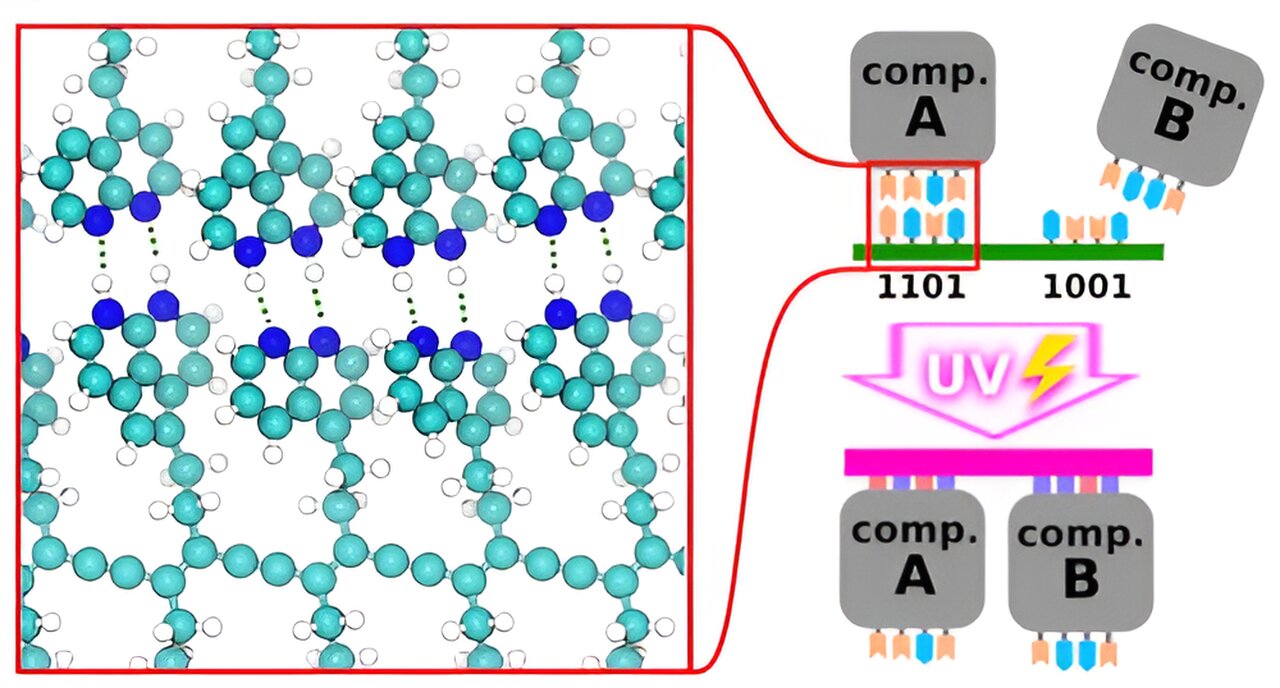× close
Molecular computer components could represent a new IT revolution and help us create cheaper, faster, smaller, and more powerful computers. Yet researchers struggle to find ways to assemble them more reliably and efficiently.
To help achieve this, scientists from the Institute of Physics of the Czech Academy of Sciences investigated the possibilities of molecular machine self-assembly building upon solutions honed by natural evolution and using synergy with current chip manufacturing.
There is a limit to the miniaturization of current silicon-based computer chips. Molecular electronics, using single-molecule-sized switches and memories, could provide a revolution in the size, speed and capabilities of computers while cutting down on their increasing power consumption, but their mass production is a challenge. Large-scale, low-defect, accessible nanofabrication and assembly of the components remains elusive. Inspiration taken from living nature could change this status quo.
Small prototypes of molecular circuits composed of a couple of molecules are currently being produced by scanning probe microscopy, which manipulates them one molecule at a time by a slow, heavy macroscopic cantilever.
Prokop Hapala, who led the study published in ACS Nano, likens it to building a delicate mosaic using a huge crane, one tile at a time. Self-assembly could solve this problem, but it creates other challenges. For instance, how do we produce a variety of structures when only a low amount of structural information can be encoded into interactions between a few functional groups?
Researchers from the Institute of Physics of the Czech Academy of Sciences took inspiration from nature, where functional and structural components are decoupled in polymer templates such as DNA or RNA. There, sugar-phosphates represent the scaffolding and the nucleobases, bonded by hydrogen bonds, provide the information storage.
Thanks to these bonds, these informational polymers can self-assemble into complex shapes and drive self-replication or synthesis of other, smaller molecules. This approach has already been utilized in “DNA origami,” which can produce complex molecules of the desired shapes and functions. But how can we scale up the process and achieve greater variety?
“Known DNA base pairs—which one can naively think would be the best choice—cannot be used as they are,” explains Paolo Nicolini, one of the authors. “They work great in the cell, but this is due to the environment and the rest of the cellular machinery. In conditions compatible with nanofabrication, they simply are not selective enough.”
Mithun Manikandan, Paolo Nicolini, and Prokop Hapala decided to combine the possibilities offered by DNA origami and photolithography to lay out complex structures of contemporary chips. This could pave the way for mass production of revolutionary molecular circuits integrated with contemporary chip-manufacturing technology—something that could enable a smooth transition from the current computer machinery to the next level.
To enable this, the researchers proposed replacing the sugar-phosphates backbone with photosensitive diacetylene. They used detailed simulations to screen for complementary hydrogen-bonded end groups that would drive the self-assembly on a lattice under the conditions used in chip production.
Diacetylene derivates were used as the backbone because they can efficiently polymerize under these conditions when primed by UV light or electron injection, and units analogous to DNA/RNA bases (the “letters” of the genetic code) were investigated in silico as the end groups driving the assembly of components into the intended shapes.
The goal was to find complementary pairs, where two units reliably bind to one another and not to other units—this trait, again analogous to how the DNA works, would enable the creation of deterministic complex circuitry patterns. The researchers found that units containing pure hydrogen donor end groups were especially suitable. Sixteen promising candidate units were found, paving the way for experimental research and eventual industry applications.
The results have interesting implications for DNA computing and artificial DNA analogs. Most feasible four-letter alphabets found in the screening occurred in a very narrow region of binding energies of 15−25 kcal/mol, and all relied on a small subset of the tested end groups.
Although only a small subset of the possible letter space could be tested with high accuracy, this suggests that the DNA alphabet may not just be a result of an “accident frozen in time,” but could have been a stable and energetically favorable option. No six-letter alphabets were found in the tested space, but new selectivity mechanisms and noncovalent bonding other than hydrogen bonds (such as halogen bonds) could potentially enable these. In a similar manner, the possibilities of therapeutical and pharmaceutical DNA analogs could be tested.
This work is going to further improve the synthetic availability of the molecules and overcome experimental limitations. While the majority of us are likely reading this on machines relying on silicon-based transistors, we could start smoothly transitioning to machines partly using molecular nano-electronics soon. This work represents another step towards such a future.
More information:
Mithun Manikandan et al, Computational Design of Photosensitive Polymer Templates To Drive Molecular Nanofabrication, ACS Nano (2024). DOI: 10.1021/acsnano.3c10575
Provided by
Czech Academy of Sciences

Wanda Parisien is a computing expert who navigates the vast landscape of hardware and software. With a focus on computer technology, software development, and industry trends, Wanda delivers informative content, tutorials, and analyses to keep readers updated on the latest in the world of computing.


